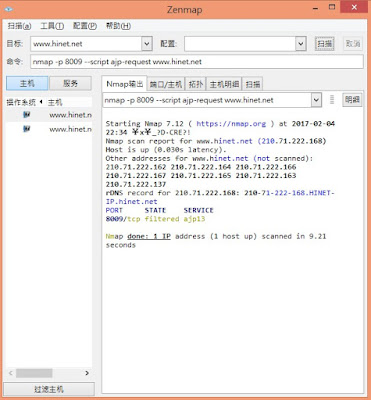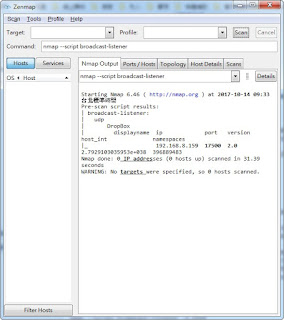broadcast-rip-discover.nse 說明
查詢LAN 裏頭, RIPv2的電腦設備, 透過發送 Request command, 取得回應
local bin = require "bin"
local ipOps = require "ipOps"
local nmap = require "nmap"
local stdnse = require "stdnse"
local tab = require "tab"
local table = require "table"
description=[[
Discovers hosts and routing information from devices running RIPv2 on the
LAN. It does so by sending a RIPv2 Request command and collects the responses
from all devices responding to the request.
]]
---
-- @usage
-- nmap --script broadcast-rip-discover
--
-- @output
-- Pre-scan script results:
-- | broadcast-rip-discover:
-- | Discovered RIPv2 devices
-- | 10.0.200.107
-- | ip netmask nexthop metric
-- | 10.46.100.0 255.255.255.0 0.0.0.0 1
-- | 10.46.110.0 255.255.255.0 0.0.0.0 1
-- | 10.46.120.0 255.255.255.0 0.0.0.0 1
-- | 10.46.123.0 255.255.255.0 10.0.200.123 1
-- | 10.46.124.0 255.255.255.0 10.0.200.124 1
-- | 10.46.125.0 255.255.255.0 10.0.200.125 1
-- | 10.0.200.101
-- | ip netmask nexthop metric
-- |_ 0.0.0.0 0.0.0.0 10.0.200.1 1
--
-- @args broadcast-rip-discover.timeout timespec defining how long to wait for
-- a response. (default 5s)
--
-- Version 0.1
-- Created 29/10/2011 - v0.1 - created by Patrik Karlsson <patrik@cqure.net>
--
author = "Patrik Karlsson"
license = "Same as Nmap--See https://nmap.org/book/man-legal.html"
categories = {"broadcast", "safe"}
prerule = function() return not( nmap.address_family() == "inet6") end
RIPv2 = {
Command = {
Request = 1,
Response = 2,
},
AddressFamily = {
IP = 2,
},
-- The Request class contains functions to build a RIPv2 Request
Request = {
-- Creates a new Request instance
--
-- @param command number containing the RIPv2 Command to use
-- @return o instance of request
new = function(self, command)
local o = {
version = 2,
command = command,
domain = 0,
family = 0,
tag = 0,
address = 0,
subnet = 0,
nexthop = 0,
metric = 16
}
setmetatable(o, self)
self.__index = self
return o
end,
-- Converts the whole request to a string
__tostring = function(self)
assert(self.command, "No command was supplied")
assert(self.metric, "No metric was supplied")
assert(self.address, "No address was supplied")
local RESERVED = 0
-- RIPv2 stuff, should be 0 for RIPv1
local tag, subnet, nexthop = 0, 0, 0
local data = bin.pack(">CCSSSIIII",
self.command, self.version, self.domain, self.family, self.tag,
self.address, self.subnet, self.nexthop, self.metric)
return data
end,
},
-- The Response class contains code needed to parse a RIPv2 response
Response = {
-- Creates a new Response instance based on raw socket data
--
-- @param data string containing the raw socket response
-- @return o Response instance
new = function(self, data)
local o = { data = data }
if ( not(data) or #data < 3 ) then
return
end
local pos
pos, o.command, o.version = bin.unpack(">CCS", data)
if ( o.command ~= RIPv2 and o.version ~= 2 ) then
return
end
local routes = tab.new(2)
tab.addrow(routes, "ip", "netmask", "nexthop", "metric")
while( #data - pos >= 20 ) do
local family, address, metric, _, netmask, nexthop
pos, family, _, address, netmask, nexthop,
metric = bin.unpack(">SSIIII", data, pos)
if ( family == RIPv2.AddressFamily.IP ) then
local ip = ipOps.fromdword(address)
netmask = ipOps.fromdword(netmask)
nexthop = ipOps.fromdword(nexthop)
tab.addrow(routes, ip, netmask, nexthop, metric)
end
end
if ( #routes > 1 ) then o.routes = routes end
setmetatable(o, self)
self.__index = self
return o
end,
}
}
action = function()
local timeout = stdnse.parse_timespec(stdnse.get_script_args('broadcast-rip-discover.timeout'))
timeout = (timeout or 5) * 1000
local socket = nmap.new_socket("udp")
socket:set_timeout(timeout)
local rip = RIPv2.Request:new(RIPv2.Command.Request)
local status, err = socket:sendto("224.0.0.9",
{ number = 520, protocol = "udp" },
tostring(rip))
local result = {}
repeat
local data
status, data = socket:receive()
if ( status ) then
local status, _, _, rhost, _ = socket:get_info()
local response = RIPv2.Response:new(data)
table.insert(result, rhost)
if ( response and response.routes and #response.routes > 0 ) then
--response.routes.name = "Routes"
table.insert(result, { tab.dump(response.routes) } )
end
end
until( not(status) )
if ( #result > 0 ) then
result.name = "Discovered RIPv2 devices"
end
return stdnse.format_output(true, result)
end
官方: https://nmap.org/nsedoc/scripts/broadcast-rip-discover.html
RIP 說明: http://www.netadmin.com.tw/article_content.aspx?sn=1010050018
nmap --script broadcast-rip-discover內容:
local bin = require "bin"
local ipOps = require "ipOps"
local nmap = require "nmap"
local stdnse = require "stdnse"
local tab = require "tab"
local table = require "table"
description=[[
Discovers hosts and routing information from devices running RIPv2 on the
LAN. It does so by sending a RIPv2 Request command and collects the responses
from all devices responding to the request.
]]
---
-- @usage
-- nmap --script broadcast-rip-discover
--
-- @output
-- Pre-scan script results:
-- | broadcast-rip-discover:
-- | Discovered RIPv2 devices
-- | 10.0.200.107
-- | ip netmask nexthop metric
-- | 10.46.100.0 255.255.255.0 0.0.0.0 1
-- | 10.46.110.0 255.255.255.0 0.0.0.0 1
-- | 10.46.120.0 255.255.255.0 0.0.0.0 1
-- | 10.46.123.0 255.255.255.0 10.0.200.123 1
-- | 10.46.124.0 255.255.255.0 10.0.200.124 1
-- | 10.46.125.0 255.255.255.0 10.0.200.125 1
-- | 10.0.200.101
-- | ip netmask nexthop metric
-- |_ 0.0.0.0 0.0.0.0 10.0.200.1 1
--
-- @args broadcast-rip-discover.timeout timespec defining how long to wait for
-- a response. (default 5s)
--
-- Version 0.1
-- Created 29/10/2011 - v0.1 - created by Patrik Karlsson <patrik@cqure.net>
--
author = "Patrik Karlsson"
license = "Same as Nmap--See https://nmap.org/book/man-legal.html"
categories = {"broadcast", "safe"}
prerule = function() return not( nmap.address_family() == "inet6") end
RIPv2 = {
Command = {
Request = 1,
Response = 2,
},
AddressFamily = {
IP = 2,
},
-- The Request class contains functions to build a RIPv2 Request
Request = {
-- Creates a new Request instance
--
-- @param command number containing the RIPv2 Command to use
-- @return o instance of request
new = function(self, command)
local o = {
version = 2,
command = command,
domain = 0,
family = 0,
tag = 0,
address = 0,
subnet = 0,
nexthop = 0,
metric = 16
}
setmetatable(o, self)
self.__index = self
return o
end,
-- Converts the whole request to a string
__tostring = function(self)
assert(self.command, "No command was supplied")
assert(self.metric, "No metric was supplied")
assert(self.address, "No address was supplied")
local RESERVED = 0
-- RIPv2 stuff, should be 0 for RIPv1
local tag, subnet, nexthop = 0, 0, 0
local data = bin.pack(">CCSSSIIII",
self.command, self.version, self.domain, self.family, self.tag,
self.address, self.subnet, self.nexthop, self.metric)
return data
end,
},
-- The Response class contains code needed to parse a RIPv2 response
Response = {
-- Creates a new Response instance based on raw socket data
--
-- @param data string containing the raw socket response
-- @return o Response instance
new = function(self, data)
local o = { data = data }
if ( not(data) or #data < 3 ) then
return
end
local pos
pos, o.command, o.version = bin.unpack(">CCS", data)
if ( o.command ~= RIPv2 and o.version ~= 2 ) then
return
end
local routes = tab.new(2)
tab.addrow(routes, "ip", "netmask", "nexthop", "metric")
while( #data - pos >= 20 ) do
local family, address, metric, _, netmask, nexthop
pos, family, _, address, netmask, nexthop,
metric = bin.unpack(">SSIIII", data, pos)
if ( family == RIPv2.AddressFamily.IP ) then
local ip = ipOps.fromdword(address)
netmask = ipOps.fromdword(netmask)
nexthop = ipOps.fromdword(nexthop)
tab.addrow(routes, ip, netmask, nexthop, metric)
end
end
if ( #routes > 1 ) then o.routes = routes end
setmetatable(o, self)
self.__index = self
return o
end,
}
}
action = function()
local timeout = stdnse.parse_timespec(stdnse.get_script_args('broadcast-rip-discover.timeout'))
timeout = (timeout or 5) * 1000
local socket = nmap.new_socket("udp")
socket:set_timeout(timeout)
local rip = RIPv2.Request:new(RIPv2.Command.Request)
local status, err = socket:sendto("224.0.0.9",
{ number = 520, protocol = "udp" },
tostring(rip))
local result = {}
repeat
local data
status, data = socket:receive()
if ( status ) then
local status, _, _, rhost, _ = socket:get_info()
local response = RIPv2.Response:new(data)
table.insert(result, rhost)
if ( response and response.routes and #response.routes > 0 ) then
--response.routes.name = "Routes"
table.insert(result, { tab.dump(response.routes) } )
end
end
until( not(status) )
if ( #result > 0 ) then
result.name = "Discovered RIPv2 devices"
end
return stdnse.format_output(true, result)
end
官方: https://nmap.org/nsedoc/scripts/broadcast-rip-discover.html
RIP 說明: http://www.netadmin.com.tw/article_content.aspx?sn=1010050018


留言
張貼留言